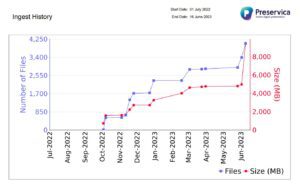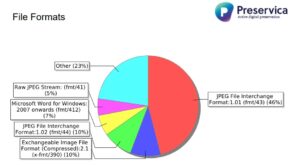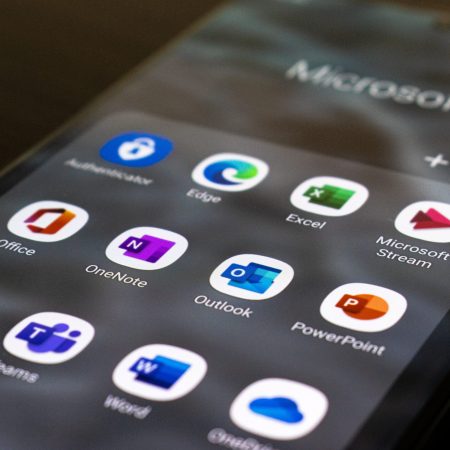Archivists are comfortable cataloguing parchment and paper-based items such as deeds, letters, maps, photographs, diaries, and analogue audio-visual items such as gramophone records, cassette tapes, cinefilm and digibeta videos (a video format often used in broadcast) – the list could go on.
Apart from the audio-visual formats, these items can be stored on a shelf in suitable conditions and in 50 or 500 years’ time, they will still be readable to the human eye. Analogue audio-visual formats need to be migrated to more recent formats to be accessible, and the resulting surrogate files are digital.
All of these formats start off as something which has a tangible existence, a hard copy format for the paper-based items. However, those digital surrogates, along with items which are born-digital, which have no hard copy existence – the photographs and videos on your mobile phone, GIS mapping, websites, and social media posts – these don’t have a hard copy existence. These and the surrogate files need particular actions to continue to be accessible into the future, and this is a digital challenge for archivists. This material needs software and hardware to access it which may be obsolete after a few years meaning digital records require regular attention over time to ensure their continued preservation and accessibility.
Hampshire Archives and Local Studies and Wessex Film and Sound Archive have been accepting digital material since at least 2005, when our first digital preservation policy was written and shared on our website. We have also been encouraging local website owners to nominate their sites for the Hampshire Collection in the UK Web Archive Hampshire Collection | UKWA Topics and Themes (webarchive.org.uk) since 2010.
In 2021, Kyle Thomason described our basic approach to digital preservation, and how we were facing the challenge of hardware and software obsolescence in his two part blog Parchment to Petabytes: Born Digital Records at Hampshire Archives (Part 1) – Hampshire Archives and Local Studies (wordpress.com) and Parchment to Petabytes: Born Digital Records at Hampshire Archives (Part 2) – Hampshire Archives and Local Studies (wordpress.com). He covered our use of DROID, a file format identification tool Download DROID: file format identification tool – The National Archives ) and the retention of multiple copies as a risk mitigation approach.
In June 2022, we achieved a step change in our digital preservation work when we had the opportunity to acquire the Preservica system, which has revolutionised this process for us. It manages a previously manual process of ingesting (adding) files to the archive system, and their migration to formats for access and preservation. This is timely as our digital accessions are growing in number.
Kyle wrote that by April 2021, Hampshire Archives and Local Studies had accepted 160GB of born-digital material. The office’s CIPFA return for 2021/22 showed that this had increased to 178Gb, so a further 18Gb had been received in a year. Preservica now contains 9Gb, comprising 4,000 new and existing files ingested since June last year. These figures demonstrate that the amount of digital material which is being added to our collections is increasing. As Kyle said, “In the past an archive would receive physical records which would then be accessioned, appraised, catalogued and made available. Today these steps are still required but new methods are needed to be able to access, read and achieve the same outcomes on a much larger scale.”

The attached graphics show the work of our digital archivist ingesting items into Preservica over the last 12 months, and the type of material this comprises, predominantly image formats so far. Of these the highest proportion are JPEGs of one type or another (45% JPEG File Interchange Format) with other image files making up at least another 25%. We also have a representation of Microsoft files, including Word (7%), some Apple files, pdfs, film including Windows Media Player and Quicktime. We also have some MIME email.

Overall, our digital archives are mainly photographs, NADFAS/Arts Society church recording reports, Quinquennial reports from the Diocese, local history research notes, and material generated by parish churches. In addition, we have the results of call outs for contributions for material related to the Covid period, Queen Elizabeth’s Jubilee and King Charles’ Coronation.
The arrival of Preservica has meant a substantial review of our digital preservation policy, and the revised version is expected to be agreed later this summer. Almost everyone is creating digital records every day. This common use of digital tools could be said to be bringing about the democratisation of archives, so everyone can contribute. This creates the opportunity to look at how we might turn this digital wave to our advantage, making it easy for potential depositors to see transferring a slice of their lives to us as a relevant action for them and something they can do in a straightforward way, to make our collections more representative. We must, of course, be mindful of that divide between the digital haves and have-nots.
We need to be aware of maintaining records’ authenticity and reliability. Authentic and reliable records are vital, but digital files have the potential to be more easily edited without obvious trace, unlike paper-based items, even by routine software updates. Archivists also need to ensure that provenance and context are incorporated into and maintained in digital archives, which may be more of a challenge, for example, if different software is used when accessing items to that used to create it.
We have the same hope for digital archives as for paper-based ones, that they arrive as organised and structured files, rather than a digital heap. So, when you are creating your own files and folders, think about their naming, rather than ‘My holidays’ or ‘My pictures’ or even ‘Tuesday’! This would save archivists worrying about whether changing a file or folder name to something more meaningful is akin to tampering with an original archive…! Maybe this is something we need to flag in future catalogues, where we have had to re-order and rename files and folders to make sense of a collection.
Making digital archives available to researchers is part of this digital challenge. At present, we have a Heath Robinson arrangement whereby the files are made available on CD or DVD in the searchroom. These formats are produced from the strongroom in the usual way to ensure their security. They are different to the digital surrogates you access onsite, for example of the tithe maps. However, as part of the work on Preservica, we are looking at how digital archives can be made available seamlessly from the catalogue on our customer terminals. This will take time to develop, after we are more familiar with the Preservica system.
We would like to encourage you to use digital archives in the same way as you would paper-based ones, and also to consider depositing digital items such as photographs, spreadsheets, CAD plans, and Publisher files. Please do contact Hampshire Archives and Local Studies, or Wessex Film and Sound Archive about this.
Bio: Heather is a qualified professional archivist with 30 years’ experience in local government archives. Her current role is Digital and Media Archives Manager for Hampshire County Council’s Archives and Local Studies / Wessex Film and Sound Archive. This covers management of digital preservation, digitisation work including audio-visual copying and external commissions, and our collections management system.

